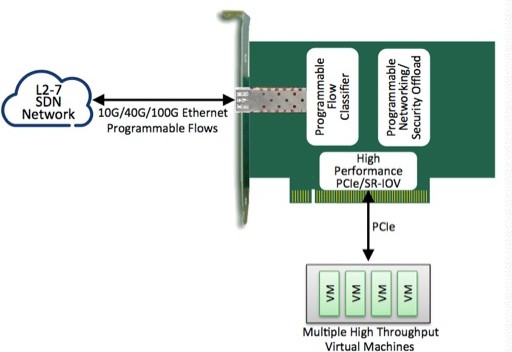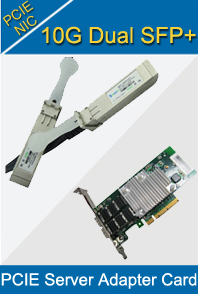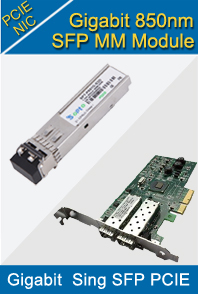PCI-E Card Knowledge
- Info about Network Interface Card Teaming
- How to Setup a Server with Multiple Network Interface Adapters?
- How to Reconnect an Internet Network Adapter for an Acer Aspire?
- 9 Things to Do When Your Internal Network Card Stops Working
- Ethernet Standards NIC for Home Networking
- What Is a Network Interface Adapter?
- How to Configure a Network Interface Card in Linux?
- How should Configure Your NIC for ISA and TMG?
- Recommended Network Card Configuration for Forefront UAG Servers
SOPTO Special Topic
Certificate



Guarantee
Except products belongs to Bargain Shop section, all products are warranted by SOPTO only to purchasers for resale or for use in business or original equipment manufacturer, against defects in workmanship or materials under normal use (consumables, normal tear and wear excluded) for one year after date of purchase from SOPTO, unless otherwise stated...
Return Policies
Applications

PCI-E NIC Cards provide redundant connectivity to ensure an uninterrupted network connection.
PCI-E NIC Cards are ideal for VM environments with multiple operating systems, requiring shared or dedicated NICs.
They are specially designed for desktop PC clients, servers, and workstations with few PCI Express slots available.
SOPTO Products
- Fiber Optic Transceiver Module
- High Speed Cable
- Fiber Optical Cable
- Fiber Optical Patch Cords
- Splitter CWDM DWDM
- PON Solution
- FTTH Box ODF Closure
- PCI-E Network Card
- Network Cables
- Fiber Optical Adapter
- Fiber Optical Attenuator
- Fiber Media Converter
- PDH Multiplexers
- Protocol Converter
- Digital Video Multiplexer
- Fiber Optical Tools
- Compatible
Related Products
Performance Feature
Recommended


- An easy way to quickly boot your PCIe-connected FPGA
If your FPGA design is connected as a PCIe device, chances are you need your design to respond within the PCIe specification’s 100msec boot-time requirement.
- Adding a PCI Device
Let's say that you have just added a new PCI-based sound card to your Windows XP computer. Here's an example of how it would work.
- Dual 10Gbps CX4 and SFP+ PCI Express Server Adapter
Sopto Dual 10Gbps CX4 and SFP+ PCI Express Server Adapter is a new 10G Server NIC adapter equipped with two 10G (SFP+ and CX4) interfaces and low-profile PCI Express form factor to bring high performance, better quality and affordable prices.
- How PCI Works
The power and speed of computer components has increased at a steady rate since desktop computers were first developed decades ago.
- Dual 10Gbps SFP+ PCI Express Server Adapter Overview
Sopto Dual 10Gbps SFP+ PCI Express Server Adapter is an optimal solution to Ethernet applications by providing strictly low-power budgets and small form factor.
- Selecting the Optimum PCI Express Clock Source
PCI Express (PCIe) is a serial point - to - point interconnect standard developed by the Peripheral Component Interconnect Special Interest Group (PCI- SIG). Although originally designed for desktop personal computers, the PCIe standard has been widely ad
- Introduction of PCI Express 2.0
PCI-SIG announced the availability of the PCI Express Base 2.0 specification on 15 January 2007. The PCIe 2.0 standard doubles the transfer rate compared with PCIe 1.0 to 5 GT/s and the per-lane throughput rises from 250 MB/s to 500 MB/s.
- PCI History
The original PC bus in the original IBM PC (circa 1982) was 16 bits wide and operated at 4.77 MHz. It officially became known as the ISA bus. This bus design is capable of passing along data at a rate of up to 9 MBps (megabytes per second) or so, fast eno
- Closing the server case
Make sure that all of the internal cables are arranged inside the case so they will not be pinched when you close the case.
- Opening the server case
Because the components inside your server are extremely sensitive to static electricity, make sure that you follow the instructions at the beginning of this step to avoid static electricity damage.
- How PCIe 4.0 Stacks Up
Given the future enhancements to the PCIe specification, the industry now has more insight into how the interconnect landscape will evolve over the next 5 to 10 years. With a handful of interconnect technologies actively competing in the market, PCIe supp
- PCI Express slot size and actual number of lanes
There is a lot of confusion created in the specifications that various online retailers provide and this sometimes leads to specs appearing to be better than they actually are. This has to do with slot size vs. the actual number of lanes running to a PCI
- How PCI Express Works
PCI Express is a serial connection that operates more like a network than a bus. Instead of one bus that handles data from multiple sources, PCIe has a switch that controls several point-to-point serial connections.
- PCI Standards and PCI Express
As processor speeds steadily climb in the GHz range, many companies are working feverishly to develop a next-generation bus standard. Many feel that PCI, like ISA before it, is fast approaching the upper limit of what it can do.
- What's driving the future of PCIe?
Since its 2003 debut, PCI Express (PCIe) has replaced PCI and PCI-X as the expansion interface of choice for consumer market PCs.
- System Bus vs. PCI Bus
Twenty or 30 years ago, the processors were so slow that the processor and the bus were synchronized -- the bus ran at the same speed as the processor, and there was one bus in the machine.
- What is PCI Express
PCI Express (PCIe or PCI-E) is a high-speed expansion card format that connects a computer with its attached peripherals. PCI Express was developed by Intel Corp.
- How to Remove a PCI Express Video Card
PCI express cards are dedicated graphics cards that assist a computer with processing and displaying 3-D graphics. This page can be useful to know how to remove a PCI express card, either to transport it and install it in a different computer, or to make
- PCIe 4.0 Bandwidth and Speed
After technical analysis, PCI-SIG determined that 16 GT/s on copper is technically feasible for the PCIe 4.0 specification bit rate.
- How to Install a PCI Card
Learning how to install a pci card is easy and once you have done this, it is like riding a bike, it will just come naturally. Here are the steps to install a pci card into a desktop computer.





